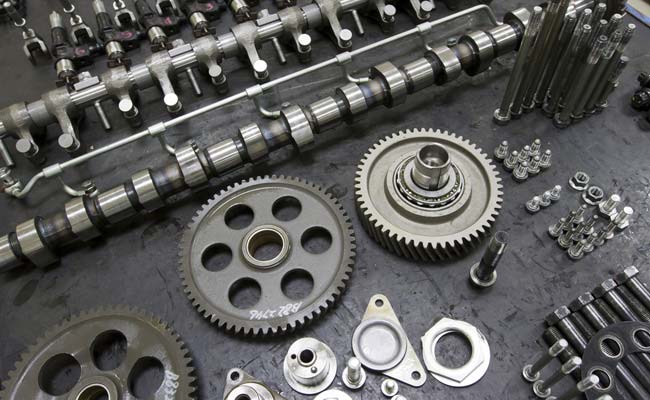
Huge potential to grow Indian auto component exports to China: ACMA
Bidhu Bhushan Palo | The Dollar Business
 China accounts for over 20% of India's auto components imports compared to just 3% of India's auto components exports
China accounts for over 20% of India's auto components imports compared to just 3% of India's auto components exports Rising wages in China and ongoing improvements in design and value addition by Indian auto component manufacturers present an opportunity to boost exports to China, according to the Automotive Component Manufacturers Association of India (ACMA), the apex body of the Auto Component Industry in India. In a study, “Export Opportunities for Made-in-India auto components for China”, ACMA says that there are export opportunities for Indian auto component manufacturers estimated at $20 billion for auto components to select OEMs in China. The study focussed on understanding the buying behaviour and the market dynamics of the Chinese automotive market and also competitiveness of the Chinese auto component manufacturers. It estimates that the export opportunity for “Made in India” components to China at $20 billion, of which the “addressable opportunity” is about $7.5 billion. Addressable opportunity exists for components such as pistons, con rods and other small engine hardware, cam and crankshafts, lighting and signalling equipment, shock absorbers, says the ACMA study. Arvind Mehta, Joint Secretary, Department of Commerce, Ministry of Commerce & Industry, Government of India, said recently that the study shows that India’s competitiveness is on the rise. “I am glad that ACMA and its members have overcome the apprehension that India cannot be competitive vis-a-vis China and have identified it as a target market. This initiative will be step forward in bridging the significant trade imbalance between China and India,” he said. Thanks to wide ranging reforms, the Chinese automotive industry has become one of the largest and the fastest growing in the world. The auto component industry in China is estimated at over $350 billion and exports estimated at around $100 billion. In 2013-14, China exported auto components worth $2.6 billion to India while India exported auto components worth only $300 million to China.
Arvind Mehta, Joint Secretary, Department of Commerce, Ministry of Commerce & Industry, Government of India, said recently that the study shows that India’s competitiveness is on the rise. “I am glad that ACMA and its members have overcome the apprehension that India cannot be competitive vis-a-vis China and have identified it as a target market. This initiative will be step forward in bridging the significant trade imbalance between China and India,” he said. Thanks to wide ranging reforms, the Chinese automotive industry has become one of the largest and the fastest growing in the world. The auto component industry in China is estimated at over $350 billion and exports estimated at around $100 billion. In 2013-14, China exported auto components worth $2.6 billion to India while India exported auto components worth only $300 million to China.
 It is heartening to see government efforts to strengthen the auto component industry, but there is an urgent need to address labour issues in the country, says Vinnie Mehta, DG, ACMA
It is heartening to see government efforts to strengthen the auto component industry, but there is an urgent need to address labour issues in the country, says Vinnie Mehta, DG, ACMAChina has taken several initiatives in restructuring of its policies that aims at increasing domestic auto and auto-parts manufacturing with foreign partners, enabling technology transfer and creating an auto-parts supply base for exports. The Chinese government has offered market access to foreign auto companies in return for technology; both soft and hard technology acquisition, which has motivated China’s opening of its auto industry to foreign direct investment. However, there have been significant macro-economic developments in China and India which have narrowed the competitive edge which China traditionally enjoyed over India, says ACMA. Rising labour costs in China and the relative movements of the currencies of the two countries vs. the USD – the depreciation of the Indian Rupee and simultaneous appreciation of the Chinese RMB, and withdrawal of various export benefits have been the key factors responsible for this. “This has also prompted some of the Indian companies that were earlier importing from China to switch to local suppliers in India,” says ACMA. The ACMA study has also identified that Chinese automobile companies such as Lifan (two-wheelers), Foton (commercial vehicles), Great Wall (passenger cars), Changan and engine manufacturers such as Weichai are now setting up facilities in India to serve the local market. Hence, this seems to be an appropriate opportunity for India to explore the possibility of increasing their exports of auto components to China possibly to narrow the trade deficit. Moreover, policy changes in India are also likely to boost auto components exports in future. Vinnie Mehta, Director General, ACMA, told The Dollar Business, “It is indeed heartening that the government recognises the potential of the auto component industry and is working to bring it back on the growth path.” He adds that the government’s proposal for extending the excise duty concessions to the automobile sector beyond December will provide further relief to automakers. Also, allowing 49% FDI in the defence sector in the recent Union Budget will open new vistas for the component makers who are keen to mitigate the risk of automotive industry cyclicality and diversify into other sectors such as defence, says Mehta.  Moreover, the government’s focus on infrastructure, skill development and enhanced funding for the development of the MSME sector, has built hopes for an early revival of the industry. “We are also enthused with the progress on the front of GST. We believe that enforcing of GST will simplify the taxation and lower taxes, broaden collection and induce spending, adding as much as 2 percentage points of growth to Asia's third-largest economy. It will also make products made in India price competitive by eliminating the cascading impact of the current taxation system,” Mehta says. However, he adds that there is an urgent need to identify and take corrective measures with regards to labour issues in the country. There is also a need to create an encouraging ecosystem, by increased thrust on IT, R&D, creation of more value added products, incentives and policy support from the government, testing and validation centres, and appropriate training infrastructure to spruce up the human resource base with the objective of positioning the Indian industry prominently on the global automotive map, says Mehta.
Moreover, the government’s focus on infrastructure, skill development and enhanced funding for the development of the MSME sector, has built hopes for an early revival of the industry. “We are also enthused with the progress on the front of GST. We believe that enforcing of GST will simplify the taxation and lower taxes, broaden collection and induce spending, adding as much as 2 percentage points of growth to Asia's third-largest economy. It will also make products made in India price competitive by eliminating the cascading impact of the current taxation system,” Mehta says. However, he adds that there is an urgent need to identify and take corrective measures with regards to labour issues in the country. There is also a need to create an encouraging ecosystem, by increased thrust on IT, R&D, creation of more value added products, incentives and policy support from the government, testing and validation centres, and appropriate training infrastructure to spruce up the human resource base with the objective of positioning the Indian industry prominently on the global automotive map, says Mehta.
This article was published on December 24, 2014.






 to success.
to success.